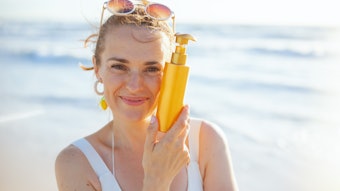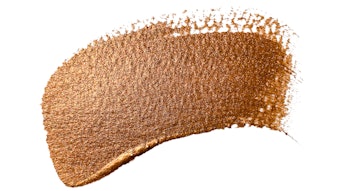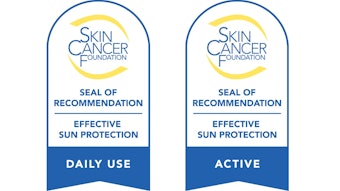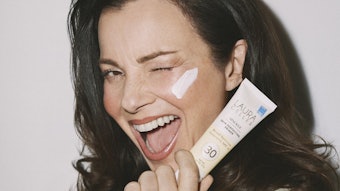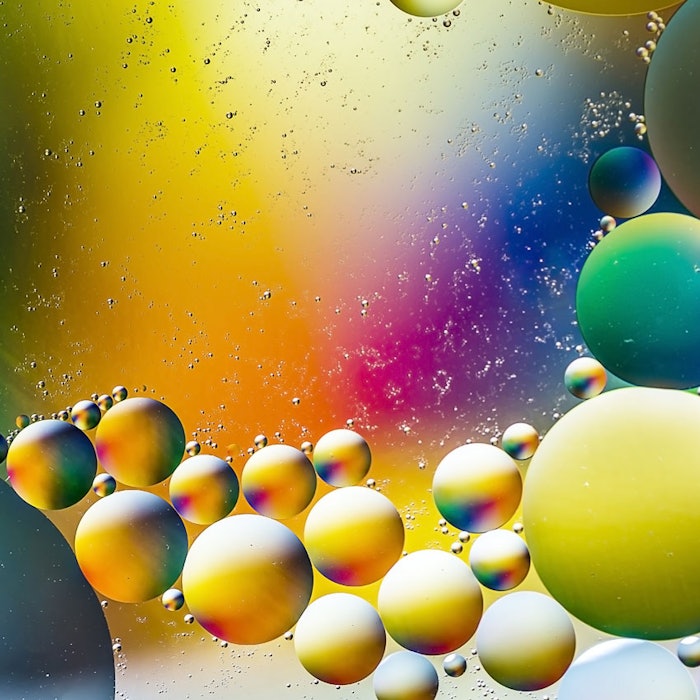
Emulsions are thermodynamically unstable systems formed by a mixture of two immiscible liquid phases and a third phase, the emulsifier.1 Emulsifiers can be classified according to their predominant chemical charge as nonionic, anionic, cationic or amphoteric. In water dispersions, each emulsifier acts via a particular mechanism to stabilize the system independently of the molecular charge.2
In sunscreens, emulsion systems make products easy to apply as they form non-oily, non-tacky, smooth films on the skin. This is crucial because it encourages consumer compliance for using a sufficient amount to obtain the full level of sun protection from the product. Furthermore, emulsions possess a variety of parameters whose features can be optimized.3, 4
Gel Network Structure and Stability
According to the gel network theory of emulsion stability, the aqueous phase consists of a liquid crystalline (LC) gel network that is generated by hydrophilic emulsifiers having a hydrophilic-lipophilic balance (HLB) > 6, with a lipophilic co-emulsifier of an HLB < 5 forming an envelope around emulsified droplets and membrane-like structures throughout the aqueous phase.5 The oil phase ideally consists mainly of liquid crystalline lipid structures. The membrane-like structures are responsible for the viscosity of the emulsion as well as for stabilizing the water-oil interface. In an aqueous medium, these membrane-like gel-network structures behave similarly to polymers—with increasing concentration, the viscosity increases exponentially.5
The appearance of liquid crystalline structures is strongly temperature-dependent. The chemistry of emulsifier and co-emulsifier determine the critical temperature for the gel network. For most cosmetic lotion systems, networks are observed to be stable below 38°C. Above this temperature, gel networks start to re-dissolve, most often transforming into isotropic micellar phases. Therefore, temperature is important not only for the stability of the emulsion in storage, but also for the production process.
Besides temperature, some constituents of cosmetic formulas are prone to stability problems. Ions from water-soluble UV filters, for instance, can interact with the emulsifier and destabilize the system. Pigments can attract amphiphilic molecules to their surface, thus reducing the emulsifier available to form the gel network.
In other cases, formulas require the incorporation of a high oil proportion into an o/w system, which poses a challenge to prevent the coagulation of the dispersed oil phase. Empirically, alkyl phosphates have proven to be versatile in such cases although it is not understood why. The objective of this study was therefore to gain a deeper understanding of what kind of emulsion structures are formed in complex sunscreen emulsions, how their appearance differs depending on emulsifier, and the emulsification power of different emulsifiers. A technique known as freeze-fracture transmission electron microscopy was used for the described studies.
Freeze-fracture Transmission Electron Microscopy
To understand how emulsifiers work, emulsions were assessed at levels close to their molecular structures. Emulsions can be complex mixtures, sometimes containing as many as 30 different ingredients. All of these ingredients may have an influence on the structure of the emulsion and its thermal stability. So to understand these structures in more detail, it was important to visualize them.
Freeze-fracture transmission electron microscopy (TEM) is a technique that provides deep insight into emulsion structures. Emulsion samples are applied as a very thin layer onto a gold grid covered by copper plates, then jet-frozena. Freeze-fracturing is followed by a freeze etching step at -100°C to enhance the visibility of liquid domains. Replicas are prepared at -150°C by shadowing with 2-nm platinum and 20-nm carbon in a freeze etching systemb. The replicas are then taken from the frozen emulsion template and cleaned, and the samples are analyzed by TEMc at an acceleration voltage of 80 kV. Pictures were taken using a CCD camerad.
Simple Emulsion TEM
Two different emulsifiers were chosen from the group of non-ionic polymeric emulsifiers and anionic emulsifiers often used in sunscreens: PEG-100 stearate and potassium cetyl phosphate (PCP)e. A model system based on a simple gel network was prepared consisting of only water, the emulsifier and glyceryl stearate as the co-emulsifier, in a ratio of 1:4. The emulsions were allowed to settle for a relatively long three-week phase, to allow full and stable development of the network before freeze-fracture TEM was performed.
Both emulsifiers formed liquid crystalline lamellar (LCL) structures and created a gel network throughout the aqueous phase (see Figure 1 and Figure 2). The smooth surfaces in the TEM pictures indicate lipophilic areas of emulsifier layers; rough surfaces indicate a water phase. The lamellar structures were densely packed, with water between the layers of emulsifier.
These simple model emulsions consisting of just three ingredients showed remarkable differences in the liquid crystalline networks formed. PEG-100 stearate led to many smaller, smooth areas of LCL structures with uneven edges. PCP gave rise to rather large, smooth LCL areas with smooth edges and sharp corners. Additionally, small and round micro-domains are visible on top of the lamellar structures, which seemed specific to PCP (see Figure 3 and Figure 4).
Complex Emulsion TEM
Since the simple emulsions revealed remarkable differences in terms of gel network, more complex sunscreens were evaluated next, for comparison. For this set of tests, in addition to samples PEG-100 stearate and PCP, glyceryl stearate citrate also was used.
All three emulsifiers formed LCL structures (see Figure 5, Figure 6 and Figure 7) and revealed their gel network throughout the aqueous phase. The lamellar structures were, again, densely packed with water between the layers of emulsifier. In the cases of PEG-100 stearate and glyceryl stearate citrate, the structures found were mainly lamellar, whereas PCP also showed a significant number of droplets/vesicles. These vesicles consisted of emollient and co-emulsifier, and also show liquid crystalline structures within the vesicles; these areas were referred to as liquid crystalline vesicular (LCV) structures.
As a next step, PEG-100 stearate as a primary emulsifier and PCP as a secondary emulsifier were combined at a use level of 0.5% in an SPF 30 sunscreen emulsion (see Formula 1). In order to maintain the same level of overall emulsifier in the formulas, the amount of primary emulsifier was reduced when adding PCP.
Interestingly, even when PCP was used as a secondary emulsifier, e.g., combined with PEG-100 stearate, the emulsion showed an increased number of LCVs. In this complex formulation, round, structured micro-domains were again found on top of the lamellar layers and especially on top of the vesicular structures (see Figure 8 and Figure 9).
In general, one layer of a mixture of emulsifier with co-emulsifier formed around the LCV structures. So in this case, it was a mixture of PEG-100 stearate, PCP, glyceryl stearate, cetearyl alcohol and behenyl alcohol. During freeze-fracturing, the top layer of LCV is ripped off and the rough surface of the inner liquid crystalline mixture of emollient and co-emulsifier becomes visible. The micro-domains, visible as round-shaped spots with a smooth surface, are most likely self-organized PCP molecules on the surface of lipid vesicles that remained on the surface after freeze-fracture. The polar head groups of PCP give the network a high negative charge in these areas. This charge distribution leads to a repulsion of vesicles that would otherwise converge (see Figure 10); such repulsion of vesicles stabilizes the emulsion, as is shown next.
Stabilization Power of Emulsifiers
As indicated, sunscreens are complex systems and it is challenging to stabilize their high oil content along with UV filters, especially during elevated temperature testing. Not only the emulsifier, but the choice of co-emulsifier and ratio of the two play a significant role in high SPF sunscreens.
To test the ability of emulsifiers to stabilize challenging ingredients, i.e., oil, inorganic particles and salt, different types of emulsifiers often included in sunscreens were used, such as anionic emulsifiers, non-ionic emulsifiers and polymeric PEG-containing emulsifiers. As the co-emulsifier, cetearyl alcohol was used at different levels, calculated so as to produce the ideal emulsifier/co-emulsifier ratio for all combinations.
Oil stabilization: To test for oil stabilization, commonly used emollients were chosen, including ethylhexyl benzoate and a 1:1 mixture of diisopropyl sebacate and caprylic/capric triglyceride. These materials represent polar, hydrophobic solvents and UV filters that are necessary to properly dissolve; they also provide a reasonably good skin feel. The formulations were produced with 1% emulsifier and increasing concentrations of oil. After 48 hr and two months of storage, the formulations were evaluated for oil separation.
PCP revealed a high potential to stabilize polar and medium polar emollients; at a concentration of 1%, it stabilized up to 75% oil (see Figure 11). The other emulsifiers tested stabilized between 50% and 60% oil. This can be explained by the presence of the exceptional number of oil-containing vesicles, as well as the presence of micro-domains stabilizing the vesicles through repulsion due the areas of high negative charge.
Inorganic nano-pigment stabilization: Besides high oil loads, inorganic nano-pigments such as titanium dioxide or zinc oxide pose a formulating challenge. Depending on the coating, these materials can adversely interact with the emulsifier system and lead to significant viscosity and stability changes. For the present study, titanium dioxide coated with silica and dimethicone was used as the pigmentary UV filter. The oil phase constituted 30% of the emulsion, and was a 1:1 mixture of diisopropyl sebacate and caprylic/capric triglyceride. Increasing amounts of titanium dioxide were formulated with 1%, 2% and 3% emulsifier, respectively. After 48 hr two months of storage, the formulations were evaluated with regard to separation (see Figure 12).
Inorganic nano-pigments like titanium dioxide or zinc oxide have large surfaces. And since part of the emulsifier is consumed to stabilize the particles, in general, larger amounts of emulsifiers are needed in such formulations. PCP again exhibited high potential to stabilize titanium dioxide; at a 1% concentration, it stabilized up to 7% titanium dioxide, while the other emulsifiers stabilized formulations of 2% to 3% titanium dioxide. Further, at a 3% concentration, PCP could stabilize up to 11% titanium dioxide, while the other emulsifiers tested stabilized 5% to 9% titanium dioxide (see Figure 12).
Salt stabilization: A third class of challenging ingredients for an emulsifier system is represented by ionic materials, e.g., water-soluble UV filters. These usually consist of sulfonated aromatic systems and are utilized in the form of salts or zwitterions. For this study, phenyl benzimidazole sulfonic acid (PBSA), a water-soluble UVB filter, was chosen. The oil phase again constituted 30% of the emulsion and was a 1:1 mixture of diisopropyl sebacate and caprylic/capric triglyceride. Increasing amounts of PBSA were formulated with 1% emulsifier. The PBSA was dissolved by neutralization with triethanolamine, and the pH of the final formulations was adjusted to 7.2. After 48 hr and two months of storage, the formulations were evaluated with regard to separation (see Figure 13).
PCP once again revealed high potential to stabilize PBSA; a 1% concentration stabilized 5% PBSA, whereas the other emulsifiers could only stabilize between 1% and 3% (see Figure 13). In an emulsion, PBSA is present in the water phase, and due to its anionic charge and the generation of micro-domains, PCP is better able to stabilize the oil droplets in this ionic environment than non-ionic emulsifiers.
Temperature stability: The ability of PCP to co-stabilize formulations against thermal stress also was investigated using PCP as the secondary emulsifier. Sunscreen emulsions with high oil loads and a targeted SPF 30 were formulated based on PEG-100 stearate (see Formula 1) and cetearyl glucoside (see Formula 2).
With a single emulsifier, these formulas were not stable when stored at 40°C. PCP at 0.5% was then incorporated; to maintain the overall amount of emulsifier in formulas, the primary emulsifier level was reduced when adding the PCP. To analyze the stability of the formulations, the viscosity was measured at certain time points during six months of storage at 40°C. Any drop in viscosity indicated changes in emulsion structure—a clear indication of less stable emulsion systems (see Figure 14 and Figure 15).
The PEG-100 stearate formulation began to separate after four months of storage. The cetearyl glucoside formulation separated after five weeks of storage. However, formulations containing 0.5% PCP were stable for one year at 40°C. PCP therefore significantly improved formulas with reduced thermal resistance, even at low concentrations.
Summary
Developing sunscreens or daily care with UV protection is challenging in terms of reaching performance goals, and the resulting compositions are often relatively complex. To avoid the need for constantly adapting emulsifier levels, these mixtures require robust emulsifying systems. In particular, high oil loads and the use of pigments, in BB creams for example, as well as ionically charged UV filters represent significant challenges to creating stable emulsion systems with pleasing sensory features.
The presented research reveals PCP to be a unique emulsifier. As shown through freeze-fracture TEM, it is able to form lamellar structures with densely packed layers of water phase and liquid crystalline lipid phases, as well as multi-lamellar vesicles containing oil stabilized by liquid crystalline structures. Comparative formulations with different emulsifiers are used globally to overcome challenges such as high loads of UV filters, pigments and salts. Here, the authors illustrated how even small amounts of PCP can optimally stabilize such emulsions.
Furthermore, the advantage of a potent emulsifier is the option to create low-viscosity but stable emulsions with a low emulsifier content, as these formulations show an improved sensory profile. And since a pleasant skin feel is a prerequisite for consumer compliance, it is proposed as a way to encourage consumers to use sufficient sunscreen to achieve better protection against harmful UV rays.
References
- AR Baby, DM Santoro, MV Robles Velasco and CH dos Reis Serra, Emulsified systems based on glyceryl monostearate and potassium cetyl phosphate: Scale-up and characterization of physical properties, Int J Pharm 361 99-103 (2008)
- M Korhonen, H Niskanen, J Kiesvaara and J Yliruusi, Determination of optimal combination of surfactants in creams using rheology measurements, Int J Pharm 197 143-151 (2000)
- HC Ansel, NG Popovich and LV Allen Jr, Farmacotécnica: Formas Farmaceuticas e Sistemas der Liberacao de Farmacos, 6th ed premier, Sao Paulo (2000) pp 299–311
- I Lachmann, HA Libermann and JL Kanig, Teoria e pratica na industria farmaceutica, Fundacao Calouste Gulbenkian, Lisbon (2001) pp 855–904
- G Dahms, workshop (2010)
